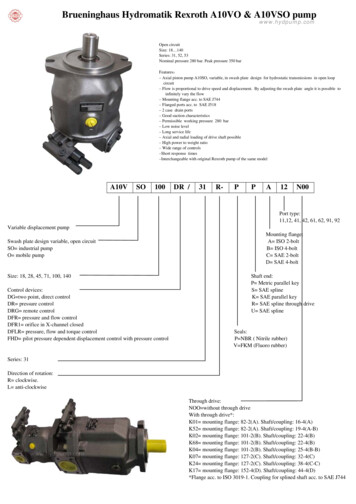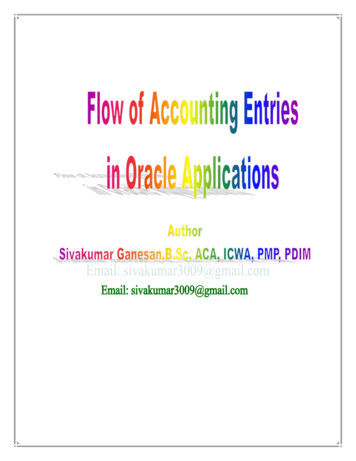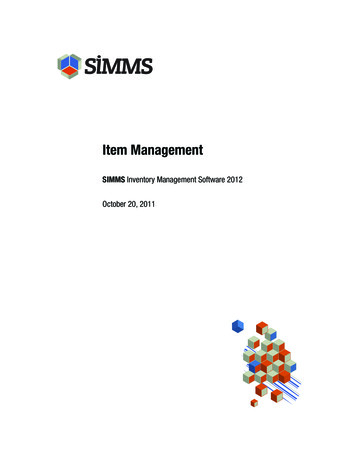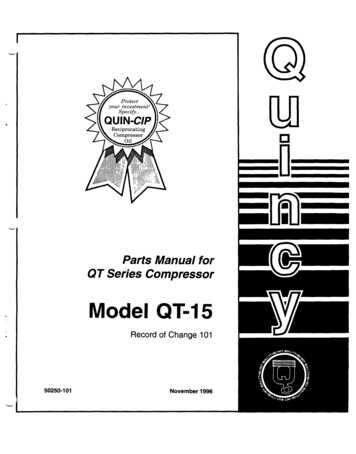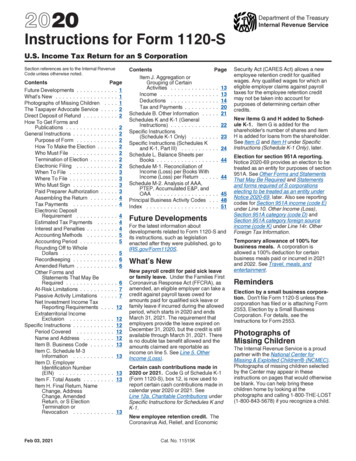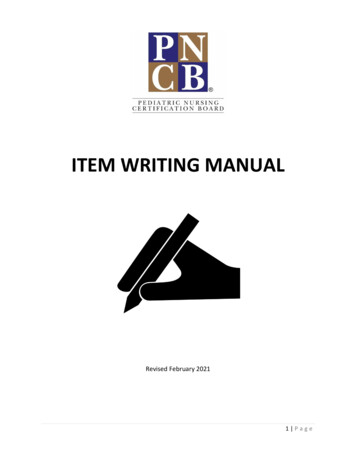
Transcription
ITEM WRITING MANUALRevised February 20211 Page
IntroductionWelcome to your endeavor to learn and develop the skills to become an item writer for the PediatricNursing Certification Board (PNCB). Our mission is to promote optimal outcomes in global pediatrichealth by providing certification services that validate specialized knowledge and continuingcompetence in pediatric nursing. This mission is directly supported by a rigorous exam developmentprocess that includes item writing. Your charge as an item writer is to develop items that ensure ourexams appropriately measure the skills, knowledge, and abilities of test-takers to determine theirqualification for certification. If you are later invited to write questions for CE modules, then your abilityto write items helps to assess learning as a part of ongoing continuing competence.Writing good test questions is both an art and a science. As you begin to develop your skills as an itemwriter, you will appreciate its challenge. Up to 60% of submitted items never make it to a scored, usablestatus in the item bank because they are either not approved for use by the exam committee or ifapproved for pretesting, do not perform well statistically. This may be due to flaws such as unclearstems, implausible distractors, or distractors that are potentially correct (you’ll learn more about theselater in the manual). By working to develop, improve, and refine your item writing skills, you canincrease the likelihood that your items will successfully progress to use as scored items in PNCB’s exams.As a volunteer, we know you want your contributions to count.This manual contains important guidance to help build your item writing skill; however, the reality isthat it will require devoting time to identify strong ideas for items and to develop the content intoquestions that appropriately assesses knowledge worthy of determining certification. As is true withmany things in life, this process comes easier to some than others. It does promise to exercise uniquecognitive abilities that will likely prove helpful to your nursing practice. This is because determining theright question to ask and the best way to frame it, is a skill needed for accurate assessment, diagnosis,and management, as well as for assessing test-takers’ knowledge to establish qualifications forcertification. In other words, asking the right question matters.This manual provides the rules and rationale for best practices in item writing, supported by the scienceof measurement and assessment known as psychometrics. You are asked to read about these practicesand apply them to your item writing. Each year before you begin your item writing assignment, it is alsoimportant to review the manual again to refresh your memory on item writing principles and PNCB styleand practices.This manual is divided into the following sections:Section 1:The Basics of Item Writing (pg. 3)Section 2:Item Writing Guidance through Examples (pg. 19)Section 3:Refining Skills and Developing Clinical Stems (pg. 31)Section 4:Critiquing your Items before Submission (pg. 38)Section 5:The Documented Item and Resource Links (pg. 39)Throughout this manual, while the term examination is the most appropriate for assessments used toestablish professional credentials, the terms “test” and “exam” or “examination” are usedsynonymously, such as when referring to test questions, test items, and test-takers.2 Page
SECTION 1: The Basics of Item WritingWhat is a test item?“Test item” and “test question” are equivalent terms and describe what is used to assess some aspect ofknowledge. The purpose of test questions is to differentiate between test-takers who have theknowledge and those who do not. Fairness is important in test questions, and items should never bewritten to be “tricky”. Items should be developed such that the test-takers with the knowledge get thequestion correct, and those without the knowledge get the question wrong.The items on PNCB’s exams are formatted as multiple-choice questions with four options (A, B, C or D)from which the test-taker selects a single correct response. This type of multiple-choice question formatis also referred to as the “one-best-answer”.A test question represents a task posed to the test-taker, which is introduced in the stem. There are twostyles of stems: a closed stem asks a complete question, punctuated with a question mark at the end; anopen stem is formatted with an incomplete or lead-in statement where each of the options completesthe sentence begun in the stem.EXAMPLES of OPEN versus CLOSED STEMSA young adolescent male is considering strength training to enhance muscle mass. Whichguidance is MOST appropriately provided?a. workouts should focus on 1-2 muscle groups on any exercise dayb. powerlifting should be delayed until later in reproductive maturation keyc. strength training should occur at least five times a week to be effectived. other forms of exercise should be avoided on days that strength training is doneAppropriate guidance for a young adolescent male considering strength training toenhance muscle mass includes thata. workouts should focus on 1-2 muscle groups on any exercise day.b. powerlifting should be delayed until later in reproductive maturation. keyc. strength training should occur at least five times a week to be effective.d. other forms of exercise should be avoided on days that strength training is done.ClosedStemOpenStemOther components of a question are the:Keycorrect option/responseDistractorsincorrect options/responsesSAMPLE QUESTIONThe MOST important reason to frequently review a child’s use of a peak expiratorySTEM flow device is becauseDISTRACTOR DISTRACTOR KEY DISTRACTOR a.b.c.d.noncompliance is prevalent.values and technique vary by brand.technique and effort affect measurements.personal best measurement must be validated.OPTIONS3 Page
The following styles of items are NOT used in PNCB exams and will NOT be accepted: True or False questionsFill-in-the-blank questionsMultiple answer or select all that apply questionsQuestions with options that include “all of the above” or “none of the above.”Questions which are negatively worded (e.g., “Which of the following is not ”, “Allof the following except ”)Exam ContentFor each certification exam, PNCB conducts initial and on-going role delineation/job analysis studies todetermine the knowledge, skills, and abilities necessary for each nursing role. The final products of thisresearch include the content outline which identifies the major domains of knowledge or contentcovered in the exam and the test specifications (e.g., how many questions are asked for each major areaof the exam). To ensure the validity and defensibility of exams, questions included in any exam mustassess knowledge related to specific areas on the content outline.PNCB maintains a bank of questions for each of its exams. Based on the knowledge a question assesses,it is classified (mapped) to the respective area on the exam’s content outline. The inventory of items byareas in the content outline is tracked and your annual item writing assignment will reflect needs in theexam’s bank. Thus, the content outline is an essential document used by the test developers whoassemble the exams, PNCB staff, item writers, and individuals preparing to take the exam. Please take amoment to review the content outline for the exam you will write to, which is located on the exam’sStudy Resources page at the www.pncb.org website.Fairness is an important requirement for test questions, and that accountability begins with the itemwriter. One aspect of fairness is that each item’s content must be congruent with knowledge reflectedin the exam’s content outline. When writing an item, you’re required to record the content area forwhich the item is written, to the lowest level that applies within the outline (see table below).EXAMPLE: Using the content outline to map items to their lowest levelExcerpt from content outline (CPN)Domain levelSubdomain levelTask levelQuestion below is mapped to III.A.1 (Domain III., Subdomain A., Task 1.)A child presents with headache, fever, and a circumferential ring rash on the forearms that itches.Assessment reveals swollen joints and the rash is warm to the touch. When obtaining the child'shealth history, it is MOST important to ask whether the child hasa. had a tick bite recently. keyb. been on a field trip with the school.c. had physical contact with a cat.d. been in contact with anyone with a similar rash.4 Page
Another aspect of fairness is ensuring that questions assess knowledge appropriate for the exam’spurpose and the role. For example, both the CPN and PMHS exams address knowledge thatexperienced pediatric nurses and mental health specialists should possess. The CPNP-AC and CPNP-PCquestions, however, are written to encompass knowledge expected for newly certified advancedpractice nurses in these areas. For any exam, questions should represent what is most prevalent andrealistic to practice, rather than asking about what is obscure or rarely encountered. Additionally, avoidwriting items about information that in practice is not routinely committed to memory; this may beinformation that changes periodically, or is information that is readily accessible in work references.Examples include immunizations required for specific international travel or certain formulas that areused for calculations.Understanding Cognitive Levels for Item WritingComplexityTest questions vary in their complexity and reflect the level of consideration and cognitive processingexpected of the test-taker to answer the item. This complexity is linked to the objective of the question.Questions in PNCB exams are written to one of three cognitive levels: recall, application, or analysis:ANALYSISQuestions that require test-takers to identify the significance andimplications of several pieces of information (if X and Y, then Z) todetermine priorities, next steps, diagnoses, or actions. In the PNCBexams, analysis questions often include a patient scenario.APPLICATIONQuestions that have the test-taker use information or knowledge in aspecific situation, such as to select an appropriate action or response.Application questions may include conditions such that the questionposes if X then Y. Application questions frequently include a patientscenario; however, the amount of data and problem-solving is less thanan analysis-based question.RECALLQuestions that require recollection of terms, facts, or other informationthat may be memorized.PNCB’s ability to assess the candidate’s knowledge, skills or abilities is strengthened by questions thatrequire higher-level thinking Thus, questions that require the test-taker to apply knowledge or analyzeinformation to identify a correct response are more relevant and valuable to the exam’s purpose thanquestions that require only recall of information. This is why working to hone your skills as an itemwriter to ask the best question for the knowledge being tested is so important. Writing higher cognitivelevel questions requires delving into topics to understand the related knowledge and to determine whatis most relevant to practice and clinical decision-making.In the table below, a selection of sample items is provided to demonstrate questions written to differentcognitive levels. When reviewing these items, consider the knowledge required to answer each questionand how it differs for each level. For example, analysis questions require knowledge of multipleconcepts to answer, which is evident in the last sample. To answer the question the test-taker mustunderstand the importance of independence to an adolescent, as well as the differences between thetypes of devices, in order to select the device that best meets this developmental need.5 Page
tic fibrosis involves dysfunction of the:a. ciliary bodiesb. endocrine glandsc. exocrine glands keyd. hypothalamusA school-age child with cystic fibrosis asks about participating in sports. Whichof the following is the BEST response?a. “Be sure to stop exercising if you start coughing.”b. “It’s important to drink plenty of fluids when you are playing.” keyc. “You can participate in any activity as long as it’s indoors.”d. “Avoid sports that cause you to breathe faster or increase your heart rate.”An adolescent with cystic fibrosis would be MOST likely to adhere to whichairway clearance technique?a. airway oscillating device such as the FLUTTER b. manual chest percussion with postural drainagec. positive expiratory pressure (PEP) maskd. high-frequency chest compression vest keySection 3 of this manual (pg. 31) contains extensive information about developing scenario-basedquestions that begin with creating a “clinical stem.” Scenario-based questions are typically application oranalysis questions, especially if the diagnosis is not stated, but must be deduced from information in thestem. For example, these questions will often ask for the priorities, appropriate treatment, or nextsteps, without the stem specifically identifying the child’s diagnosis.Developing item contentWriting well-developed items for exams important enough for establishing credentials takes time andeffort. That effort includes exploring topic ideas (based on your item writing assignment) andconsidering how it relates to your practice experience, as well as perusing references. While journalarticles may be reviewed for content ideas, questions must still be referenced to PNCB approvedreferences (specific to the exam you are writing for). It takes some mulling and pondering, and thenchallenging yourself to delve into a topic to consider many aspects of clinical implications. Generally, it iswisest to avoid writing the first question idea that comes to mind (or keep it on hold for a bit). The mostobvious question on a topic has likely already been written many times.Once you have your idea for an item, the actual execution takes time. Some item writers find it helpfulto begin with writing an objective for the question identifying what knowledge they are intending toassess. After completing the item, review your original statement to ensure that what you have writtendoes indeed assess the intended knowledge.6 Page
EXAMPLE: An Item Writer’s Objective and ItemObjective: Test-takers should knowItem: Which of the following is the best position for anspecific techniques for making a small apprehensive toddler during a physical exam?child comfortable during a physicala. reclining on examiner’s and caregiver’s laps as they sitexam.knee to knee keyb. seated on the exam table and allowed to remainuprightc. reclining on exam table holding comfort objectd. reclining on exam table with head in caregiver’s lapAs you begin writing your item, develop a stem that asks a question in a fair, directed manner that: contains ALL the information the test-taker needs to answer the question is easily readable by eliminating extraneous information not needed to answer the question establishes a clear task/expectation for the test-takerThe next task is to write the correct response, followed by developing plausible but incorrect options,known as distractors. The role of distractors is to attract the test-taker who lacks the knowledge and isguessing. Distractors should be plausible, but incorrect, and not easily dismissed by test-takers. Yourquestions need to avoid cues that make guessing easy, and ensure the correct response blends-in wellamong the options.EXAMPLE: An Easily Dismissed DistractorWhich of the following individuals was the first president of the United Statesof America?a. John Adamsb. George Washington keyc. Alexander Hamiltond. Bill Clinton easily dismissed as not from the same period in historyWith all these requirements (and many more detailed throughout this manual), it is easy to understandwhy a commitment to critiquing and editing your item several times before its final submission is anecessary part of creating quality items. While your strong knowledge of pediatric practice is a trueasset to this endeavor, it is usually the investment in time and effort that most often differentiatesweaker versus stronger items.Item Writing RulesRule #1: Promote fairness in your test questionsWrite clearly and succinctlyThe fairness of a test question is promoted by ensuring it is written with clarity and succinctness.Why is this rule critical in your test questions? Most people can identify with experiencing someanxiety or nervousness about test-taking, especially when the exam is used to establishimportant professional credentials. It is unfair to add to that anxiety by padding questions withinconsequential information that causes the test-taker to waste time reading and consideringinformation that is not pertinent to the subject matter. For example, a common flaw by newitem writers is including the setting where the child was seen, which is generally unnecessary7 Page
information. Keeping items succinct helps promote fairness by minimizing reading load sinceassessing reading comprehension is not the purpose of PNCB’s exams.A test question sets up a clear task for the test-taker, containing all the information necessary toselect the correct response. If an item is well-written, the test-taker who has the knowledgeshould be able to anticipate the correct response before even reading the options. It shouldNEVER be necessary to read the options to understand what a question is asking.Poorly developed stems can occur when the question is too broad to define a clear task. Thistype of flaw is referred to as an undirected stem, which will require revision. The undirectedstem creates an unfair question as the test-taker tries to determine what exactly is expectedwhen the possibilities may seem limitless. An example of an undirected stem is: “Whencompleting a physical assessment on a child it is important to ” In this example it is easy toimagine the hundred or more possible important aspects of physical assessments that could bean answer.Asking “Which of the following ” is phrasing included in many stems. By following this phrasewith a noun/subject to define what “which of the following” is referring to, the stem becomesmore directed. See how this is accomplished in the revised version of the item in the tablebelow.EXAMPLE: Making the stem more directORIGINALAn adolescent presents with a pierced navalthat is swollen, erythematous, and has purulentexudate. Which of the following is the MOSTappropriate?a. prescribe oral antibiotic therapyb. remove jewelry from navalc. prescribe topical therapyd. cleanse with peroxideREVISEDAn adolescent presents with a pierced navalthat is swollen, erythematous, and haspurulent exudate. Which of the followingACTIONS is MOST appropriate?”The addition of the noun after “Which of thefollowing” improves the directness of thequestion, as test-takers now understand thatthey are identifying “appropriate ACTIONS”.If option B had been a treatment, as are theother options, then ACTIONS could have beenreplaced with TREATMENT.Stems that ask, “Which of the following is true (or correct or accurate) about .”, all create verybroad and undirected stems, and therefore they are not used in exam questions.In striving for succinctness, keep in mind that the purpose of the test or questions is not toteach. When writing stems, avoid introductory statements that teach. For example, the firstsentence in the following stem is teaching and unnecessary:“Assessing changes in pulmonary function affecting the child’s functional status isimportant. Which of the following devices provides an objective method of measuringasthma severity and is most helpful in assessing function?”8 Page
Helpful HintAfter you write your item, leave it for a while. Later, with a fresh eye,re-read the question. Consider the objective of the question and askyourself what information the test-taker really needs to answer thequestion. Edit your question to remove extraneous words.Do not write negatively stated stemsA negatively stated question requires an active shift in logic for the test-taker, who must nowfocus on recognizing a single exception. This shift requires the test-taker to recognize severalcorrect options but select an option that is incorrect. Because of this required shift in logic andthe risk that the test-taker will overlook the “negative” word in the stem (which happens), thisstyle of question is considered somewhat unfair.Examples of negatively worded stems All of the following studies are used to establish the diagnosis of malrotation EXCEPT:Which of the following is NOT a diagnostic study used to diagnose malrotation?Which is the LEAST likely cause of .EXAMPLE: NEGATIVE Stem with Options Which of the following interventions is NOT recommended to decrease the frequency ofinjury/death of adolescent drivers?a. A learner permit period that lasts at least 6 months recommendedb. Passenger age restrictions recommendedc. 50 hours of adult supervised road driving recommendedd. Use of hands-free mobile devices key NOT recommendedThe only negative stem questions that are allowed are related to knowledge that is specificallylearned in that context. For example, knowing certain CONTRAINDICATIONS (to therapies,medications, etc.) is knowledge important and relevant to clinical practice, and therefore,questions asking about these are accepted.Limit the use of age and genderWhen writing questions, consider if there is real significance to knowing the age of a child forthe knowledge being tested. Test-takers should not be distracted considering the potentialinfluence of age unless it is critical to the knowledge being assessed.If age is important to include, consider if a specific age is necessary or whether referring to anage group is reasonable. The age groups included in PNCB’s style are: newborn, infant, toddler,preschooler, school-age child, or adolescent. The use of terms such as “baby” or “teen” shouldbe avoided unless used within a quotation as stated by a caregiver or parent. When a specificage is not important, the use of “child” is appropriate, and preferred over the use of “patient”.This same principle relates to gender. Introducing a child’s gender should be avoided unless it isrelevant to the knowledge being tested. At times this takes a bit of creativity in editing and9 Page
arranging words. Try your best, although sometimes it seems unavoidable. The challenge oftenis related to the English language lacking a gender-neutral possessive pronoun, and “their”cannot be grammatically used for a singular child. The exception to this is when the question’scontext is related to gender identity requiring the use of a gender neutral or gender inclusivepronouns.Be careful to avoid introducing a child’s gender in an option when it was not previouslyintroduced in the stem, as this can be confusing to the test-taker. If it can’t be resolved withediting, then introduce the child’s gender in the stem.Avoid referring to the “nurse” or “nurse practitioner” in the questionQuestions should NOT be worded to refer to the nurse or nurse practitioner (NP) or to ask whatthe nurse or NP should do. As the test-takers, the nurse or NP is already the implied audiencefor the question. If your questions refer to the nurse or NP, take time to revise your items andpose the question more directly.EXAMPLE:When selecting an appropriate gauge needle, the nurse should REVISED:When selecting an appropriate gauge needle, it is important to Including the terms “nurse” or “nurse practitioner” may be appropriately used in questionswritten for professional practice topics, such as those assessing knowledge about licensure,regulations, or ethics.Keep “YOU” out of the questionQuestions should NOT be worded to include the word “you.” The reason for this is ratherhumorous. For example, if the question asks, “When giving an IM injection to an adolescent inthe deltoid muscle, which needle gauge would you use?” the wording suggests the objective isto identify your personal preference or choice. There is no way to mark a question correct orincorrect that is asking a personal choice. Therefore, NEVER include “you” in the question, andinstead write the question to ask for the appropriate action or response.Other guidelines for promoting fairness, clarity and succinctness: Do NOT personalize children, their families, or the nurse by giving them names.Do NOT use the term “patient”; refer to “the child”, if needed.Keep questions focused on a single objective. Avoid trying to assess as much as possibleabout the test-taker’s abilities from a single clinical situation.For example, a stem that asks, “What is the diagnosis and best treatment plan based oncurrent condition?” is addressing two objectives. Focusing on a single objective is moreappropriate. Thus, this question should ask either about the diagnosis OR abouttreatment, but not both. When an item includes a scenario, address the child’s status first, followed by thequestion. See the two examples below and note how it is easier to read and understandthe item when the clinical context is presented before asking the question. Readability isalso improved with breaking the question up into 2 sentences. (Do keep in mind thatmost clinical scenario questions are limited to 3 sentences.)10 P a g e
Example 1: Question FirstExample 2: Child First PREFERREDWhich is the BEST initial treatment for a10 year old who presents with a 6-monthhistory of headaches twice a monthdescribed as frontal, pounding, lasting formost of the day, and accompanied bynausea and light sensitivity? A 10 year old presents with a 6-monthhistory of headaches twice a monthdescribed as frontal, pounding, lasting formost of the day, and accompanied bynausea and light sensitivity. Which is theBEST initial treatment?Present patient-related data in the stem, such as presenting concerns or exam findingsin a logical sequence. For example, assessment findings that are included might besequenced from head-to-toe.EXAMPLE: Sequencing physical exam findings in a logical orderA caregiver presents for concerns with infant’s tiring with feeding,diaphoresis, and heavy breathing. Vital signs include a HR 175 bpm, RR60/min, SpO2 97% in RA, and BP 80/50. Physical examination revealsacyanosis, rales over bilateral lung fields, a harsh, blowing, 3/6 holosystolicmurmur, liver edge 3 cm below the right costal margin, and 2 pulses in allextremities although slightly cool. The MOST likely diagnosis is:a. atrial septal defectb. coarctation of the aortac. ventricular septal defect Keyd. truncus arteriosus Do not write questions that expect the test-taker to recognize specific theorists bynames. It is acceptable to write questions related to the application of their theories,such as those related to child development.Questions should not provide cues that make it easier for test-takers who guess at thecorrect answer. Carefully review and edit options to ensure the correct response blendsin among the distractors by being similar in length and complexity.What to look for:ooIf a significant term used in the stem is only repeated in the key, try to removethe term or remedy it by including it in at least one of the distractors.If the correct response is longer and contains more detail than the distractors,try to fix by either shortening the key or adding more detail to at least onedistractor.SAMPLE QUESTIONWhen working to create parallelstructure among the options, try toensure balance in their complexity. Forexample, if one option includes an“and” or even a comma, so shouldanother option, especially if one ofthose options is the correct xxxxxxxxx:a.b.c.d.aaaaaa aaaaaaaaaa.bbbbbb and bbbbbbb bbbbb bbbbbbb.cccccccccc and ccccccc cccccccc ccccccccc.ddddd dddddddd dddddd ddddddddddddd.11 P a g e
When options containing numeric ranges, ensure that they are distinct with no overlapto avoid the possibility that two options are correct. (see Example 4, pgs. 20 and 25)Verify that the option identified as the key (correct response), is the ONLY correctoption.Additional guidelines that promote sensitivity and fairness: Persons are not defined by their disease or disability. Person-centered orientation ismore appropriate for ensuring the fair representation of individuals. For example,instead of referring to “the diabetic child”, use “a child with diabetes”.Children do not come exclusively from two-parent families, and two-parent families arenot exclusively comprised of a father and a mother. The individual responsible for thechild’s care may not even be a parent. Vary your use of the terms caregiver(s),parent(s), or mother or father, to promote balance and representation within youritems and within our exam banks.A physician may not be the only healthcare professional on the team prescribing care,medications or treatments. For that reason, it is more appropriate, where applicable, touse the term healthcare provider as opposed to physician.Specific words, when included in the stem, are capitalized to help ensure that the testtaker does not overlook emphasis related to the question’s task. These terms includethe following words: MOST, BEST, NEXT, FIRST, FIRST-LINE, INITIAL, PRIORITY,IMMEDIATE, and CONTRAINDICATION.Rule #2: Distract with your distractorsThe incorrect responses in a multiple-choice question are called distractors. They are intendedto distract by appealing to those test-takers who do not have the knowledge and are likely to beguessing. Strong distractors strengthen questions and help to differentiate between those whopossess the knowledge from those that do not. Work to ensure distractors have someplausibility, because when a distractor is easily dismissed or discounted, the odds improve forguessing correctly. However, it is critical that distractors should be incorrect un
This manual provides the rules and rationale for best practices in item writing, supported by the science . PNCB staff, item writers, and individuals preparing to take the exam. Please take
